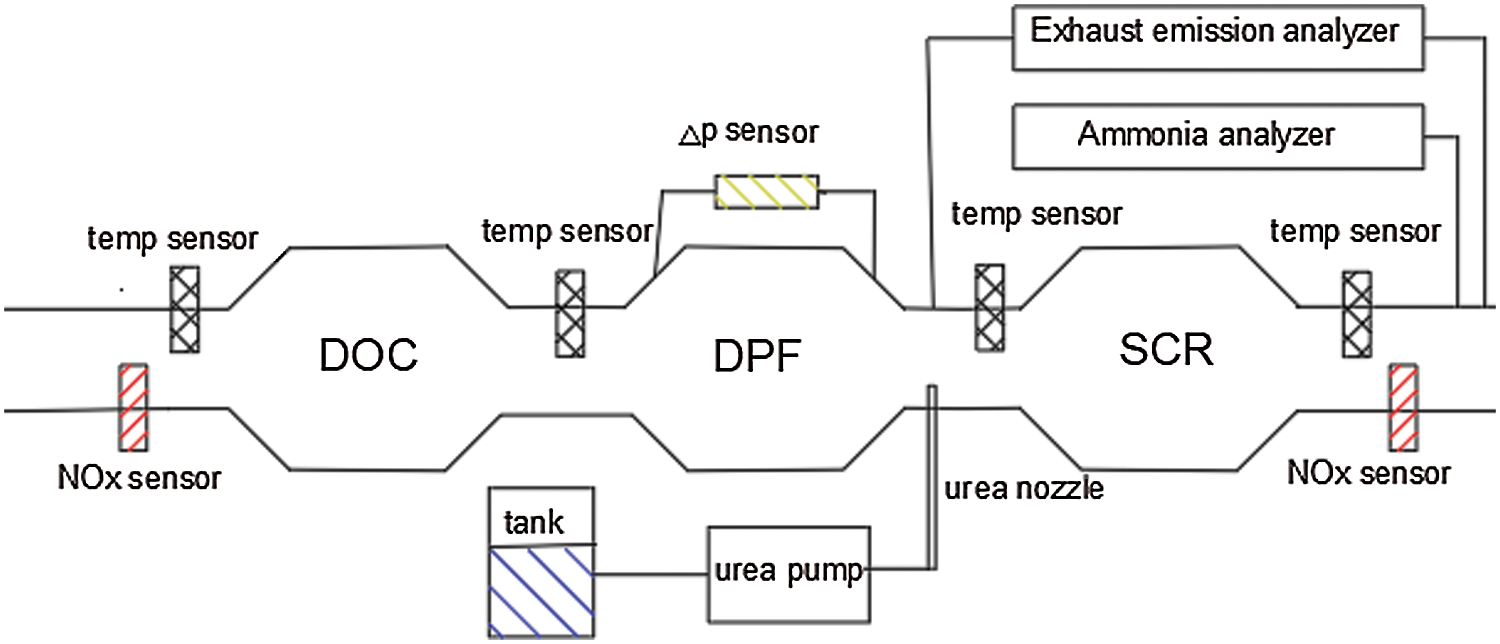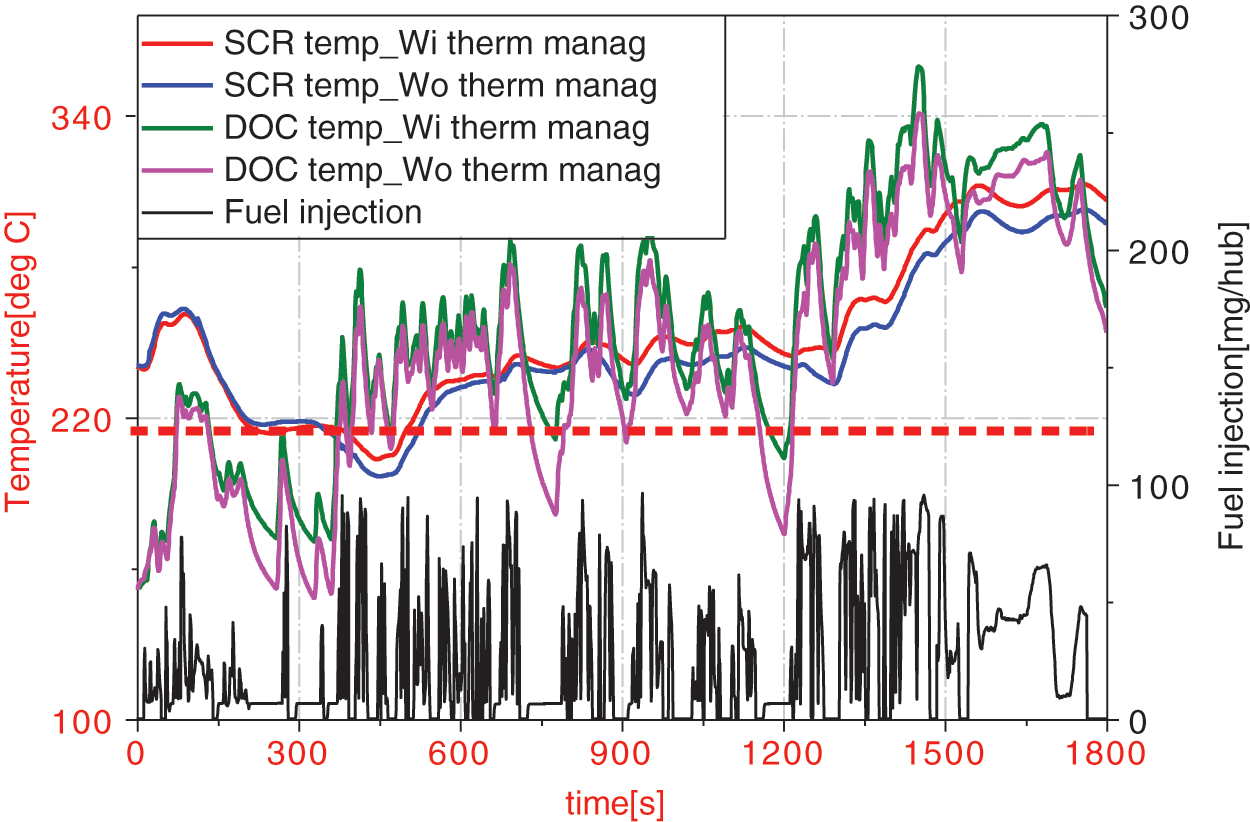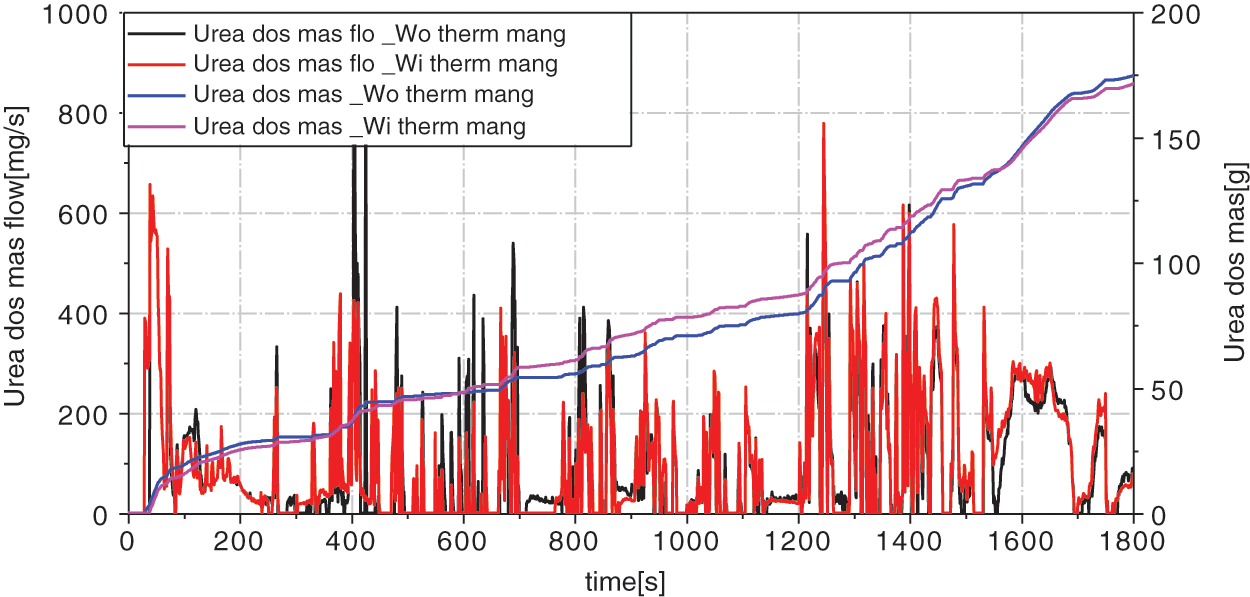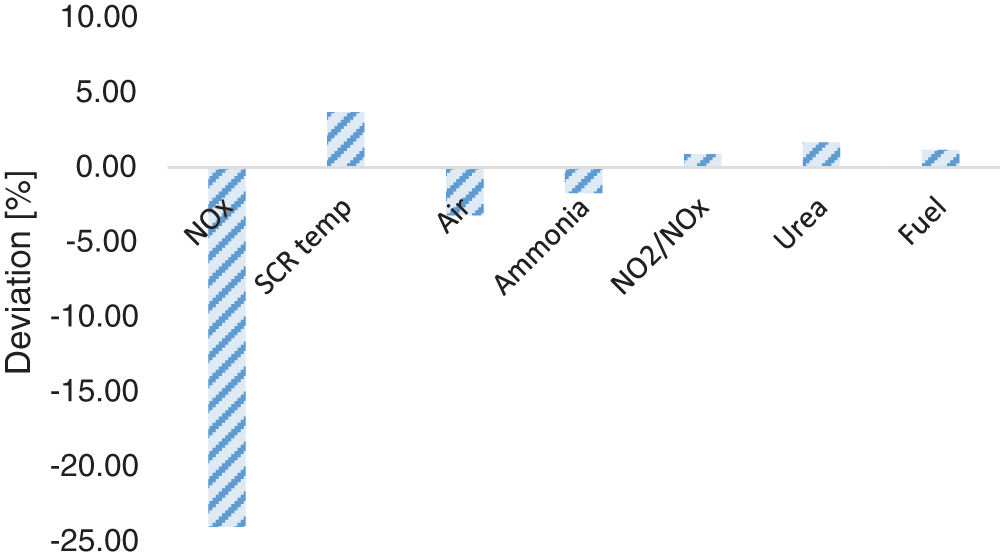

 | Fluid Dynamics & Materials Processing |  |
DOI: 10.32604/fdmp.2022.019311
ARTICLE
Experimental Analysis of the Influence of Exhaust Thermal Management on Engine NOx Emission
1School of Energy and Power Engineering, Shandong University, Jinan, 250061, China
2China Automotive Technology & Research Center Co., Ltd., Tianjin, 300300, China
3National Engineering Laboratory of Mobile Source Emission Control Technology, Tianjin, 300300, China
*Corresponding Authors: Ke Sun. Email: sunkeke@sdu.edu.cn; Shuzhan Bai. Email: baishuzhan@sdu.edu.cn
Received: 16 September 2021; Accepted: 03 December 2021
Abstract: Exhaust thermal management is essential to allow engines to meet the Euro VI emissions standards and reducing nitrogen oxide emissions is one of the most important targets being pursued nowadays. Along these lines, in the present study, engine’s thermal performances have been evaluated on the basis of a WHTC test, namely a transient engine dynamometer schedule defined by the global technical regulation (GTR) developed by the UN ECE GRPE group (the GTR is covering a world-wide harmonized heavy-duty certification (WHDC) procedure for engine exhaust emissions). The influence of thermal management on fuel consumption, intake, and tailpipe NOx have been quantitatively analyzed for the overrun state. The results have shown that there can be a strong influence on the after-treatment temperatures and tailpipe NOx. In particular, the average temperature upstream of the diesel oxidation catalyst (DOC) has been found to increase from 245°C to 254°C, the average temperature of the selective catalytic reduction (SCR) to increase from 248°C to 253°C, the SCR’s minimum temperature to increase from 196°C to 204°C, and the peak value of the NOx emissions in the low-temperature region to decrease from 73 to 51 mg/s. However, the influence of the overrun state’s thermal management strategy on the fuel consumption, the air intake, the ammonia storage, the NO2/NOx ratio, and the urea consumption has been observed to be relatively limited.
Keywords: Intake throttling valve; NOx emissions; overrun; diesel
Nomenclature
| CWEngine | engine cycle work |
| dmair | air mass flow |
| dmNOx | NOx mass flow |
| K | impulse coefficient |
| n | engine speed |
| P | gas inlet pressure |
| R | gas constant |
| SENOx | specific emission |
| Tair | gas inlet temperature |
| u | molar mass of the mixed gas |
| Veng | theoretical total cylinder volume |
| cpsi | cells per square inch |
Graphical Abstract
The figure shows the intake throttling valve’s influence on the engine’s exhaust temperature under the world harmonized transient cycle (WHTC). The exhaust temperature upstream of the diesel oxidation catalyst (DOC) increased by 22°C, 24°C, 29°C, and 30°C during the four long idle regions. This shortened the low-temperature region sensitive to the selective catalytic reduction’s (SCR’s) efficiency and reduced the NOx tail emissions from 0.21 to 0.16 g/kW⋅h, a decrease of 24%.

Strict nitrogen oxide (NOx) emissions from heavy-duty diesel engines require clean combustion in the cylinder and an efficient after-treatment system [1]. Copper (Cu)-based selective catalytic reduction (SCR) have good nitrogen oxide conversion efficiency and hydrothermal stability at low temperatures [2–4]. Cu-based SCR with urea as the ammonia source is considered a primary technology that meets the Euro VI NOx emissions standards for heavy-duty diesel engines [5–8]. The world harmonized transient cycle (WHTC) is a transient test cycle with 1,800 operating points. It includes a cold-start WHTC and a hot-start WHTC, and a test cycle runs for a total of 1,800 s. The first 600 s simulate urban working conditions, the middle 600 s simulate suburban working conditions, and the final 600 s simulate high-speed working conditions. Euro VI emissions regulations require the WHTC tail exhaust NOx, including the after-treatment aging coefficient (with a value of 1.15), to be less than 0.46 g/kW⋅h. Engineering margin coefficients, such as the product consistency, are generally set to 1.1; therefore, the NOx emissions should not exceed 0.36 g/kW⋅h. The cold-start WHTC, which accounts for nearly 15% of the total emissions weight, cannot inject urea when the SCR’s temperature is low, which results in high NOx tail emissions. Therefore, the hot-start WHTC attempts to control the NOx emissions so they are as low as possible.
Many factors, such as the space velocity, the temperature, and the ammonia–nitrogen ratio, affect an SCR’s conversion efficiency. Among these, the temperature has the largest effect on the nitrogen oxides [9,10]. Research regarding an SCR’s catalyst activity at low temperatures has garnered much attention, and many studies have been performed in this field [11–15]. Research concerning diesel engines’ thermal management has primarily focused on medium and low engine loads [16–19]. Zhang et al. [20] studied the method of injecting a small amount of diesel upstream of the diesel oxidation catalyst (DOC) and then changing the engine’s operating point to increase the after-treatment temperature. Guan et al. [21] studied the effects of intake throttling, the intake valve’s closing timing, a lower injection pressure, late injection timing, and exhaust gas recirculation on the exhaust temperature under low loads. However, few studies exist for no-load thermal management of the exhaust temperature. In this study, the WHTC was used to evaluate the exhaust thermal management’s effects when there was no load on the engine. The results can provide a reference for diesel engine temperature management.
2 Experimental Setup and Methods
The test engine was an electronically controlled high-pressure common rail Euro VI engine. The air intake system was a supercharged waste gate turbocharger (WGT) intercooler with exhaust gas recirculation (EGR) and a throttling valve (TV). The post-processing configuration consisted of a diesel oxidation catalyst (DOC), a diesel particulate filter (DPF), a selective catalytic reduction (SCR), an ammonia slip catalyst (ASC). The pipe used during the tests was a standard truck exhaust pipe wrapped with insulating layer, and the temperature dropped by 11°C–12°C from a point downstream of the turbine to a point upstream of the DOC. The length of the exhaust pipe used on the test bench, 2.4 m, was the same as that required for a vehicle’s pipeline layout. The urea injection system used a Bosch DeNOx2.2 system. A Continental Automotive Electronics Co., Ltd. (China) 2.8 generation onboard NOx sensor was installed downstream of the turbine and the SCR. Bosch temperature sensors were installed upstream of the DOC, the DPF, and the SCR, as well as downstream of the SCR, as shown in Fig. 1. Tables 1 and 2 present the specifications for the test engine and catalyst, respectively.

Figure 1: Schematic of the after-treatment layout


The WHTC is composed of 1,800 transient operating conditions and runs for a total of 1,800 s. The total WHTC consists of both cold- and hot-start WHTCs. The test cycle in this study was a hot-start WHTC. Four intervals are long idle speed, which are 190–255 s, 275–325 s, 705–770 s, and 1145–1200 s, respectively.
An engine is in the overrun state when it has little or no fuel injection. For an engine in this state, the uncontrolled and controlled inlet throttling valves were compared. Then factors influencing the nitrogen and oxygen emissions, including the air intake, the after-treatment temperature, the NO2/NOx ratio, the ammonia storage setting, and the urea injection, were studied.
3.1 Intake Throttling Valve’s Influence on the Air Intake
The intake throttling valve affected the combustion temperature by affecting the combustion in the cylinder. Fig. 2 shows that when the engine was in the overrun state, the intake throttling valve’s opening degree was different and the intake air’s mass flow without thermal management measures was not actively controlled (the intake throttling valve’s opening degree was 0%), as shown by the red line. The throttle valve with thermal management measures throttled the intake air (the intake throttle valve opening is 90%), as shown by the blue line. At other loads, the blue and red lines coincided, indicating that the engine’s air intake mass flow were the same.

Figure 2: Intake throttling valve’s opening degree
The air intake throttling valve’s different opening degrees affected the engine’s air intake. As shown in Fig. 3, when the engine was in the overrun state, the intake air mass flow, with and without thermal management measures, were 70 and 130 kg/h, respectively, and were nearly the same for the other working conditions. The total intake air was composed of fresh air and exhaust gas recirculation. When thermal management measures were applied, the WHTC’s total intake air changed from 455,326 to 440,845 kg, a decrease of 3.2%. Eq. (1) presents the formula used to calculate the total intake air mass flow [22].

Figure 3: Engine intake air mass flow
In Eq. (1), dmair is the total intake air mass flow, n is the engine speed, K is the impulse coefficient, P is the gas inlet pressure, Veng is the theoretical total volume of the cylinder, u is the molar mass of the mixed gas, R is the gas constant, and Tair is the gas inlet temperature.
3.2 Intake Throttling Valve’s Influence on the Exhaust Temperature
The SCR’s reaction and the DPF’s active regeneration were closely related to the after-treatment temperature. The after-treatment temperature is one of the key aspects of the Euro VI engines. Fig. 4 shows the thermal management strategy’s influence on the temperature upstream of the DOC and SCR under WHTC. The thermal management strategy effectively increased the test cycle’s exhaust temperature. The minimum temperature upstream of the DOC increased from 153°C to 175°C during the engine’s first overrun period when the thermal management strategy was incorporated. During the second, third, and fourth overrun periods, the minimum temperature upstream of the DOC increased from 150°C to 174°C, from 183°C to 212°C, and from 173°C to 203°C, respectively. The average temperature upstream of the DOC increased from 245°C to 254°C.

Figure 4: Engine exhaust temperature
The DOC’s temperature change affected the SCR’s temperature. The lowest temperature upstream of the SCR increased from 196°C to 204°C when thermal management was utilized. Under the WHTC, the average temperature upstream of the SCR increased from 248°C to 253°C. Temperature was the most important factor that affected the SCR’s conversion efficiency, and it was especially critical in the low-temperature area. The SCR, coupled with thermal management strategies, could improve the conversion efficiency of nitrogen oxides.
3.3 Intake Throttling Valve’s Influence on the NO2/NOx Ratio
The oxidation of NO to NO2 in the DOC was primarily affected by the temperature and the space velocity. The composition of the NO2/NOx mixture affected not only the NH3 and NOx reaction rate, but also the urea consumption. Under the WHTC, the upstream NOx changed sharply; the peak value reached 830 ppm and the average value was 295 ppm. Fig. 5 shows that the NO2/NOx ratio had many burrs, which were primarily affected by the space velocity. During the first 1,300 s of the WHTC, the DOC’s temperature was lower than 310°C, and the NO2/NOx ratio was positively correlated with the after-treatment temperature. After 1,300 s, the DOC’s maximum temperature reached 360°C, and the NO2/NOx ratio was negatively correlated with the after-treatment temperature. During the first half of the WHTC, the NO2/NOx ratio was less than 50%, and the fast and standard NH3 and NOx reactions occurred in the SCR. During the WHTC’s second half, the NO2/NOx ratio was more than 50% at some operating points and a slow reaction of NH3 with NOx occurred. Under the WHTC, the mean value of the NO2/NOx ratio changed from 33.7% to 34.6% with the thermal management strategy, an increase of 0.9%.

Figure 5: NO2/NOx ratio upstream of the SCR
3.4 Intake Throttling Valve’s Influence on the Emissions Performance
The primary factors affecting the NOx conversion efficiency were the temperature, the space velocity, and the ammonia storage. Figs. 6 and 7 show the effects of the temperature and the space velocity, respectively, on the NOx emissions under the WHTC. There were two primary parts of NOx escape in the hot-start WHTC. A large amount of NOx escaped from between 400 and 500 s; this was caused by a low SCR temperature. A small amount of NOx also escaped between 1200 and 1400 s because of the large space velocity. The mass flow of the NOx was determined by the engine exhaust, the volume concentration of the NOx, and the moles of gas [23], and its formula is shown in Eq. (2).

Figure 6: Influence of the temperature on the NOx emissions

Figure 7: Influence of the space velocity on the NOx emissions
In Eq. (2), dmNOx represents the mass flow of the NOx, NOx_ppm is the volume concentration of the NOx, dmEG is the mass flow of the exhaust gas, NOx_mol is the molecular weight of the NOx, and EGmol is the molecular weight of the tail gas.
After the addition of the thermal management measures, during the first instance of escaping NOx (400–500 s), the maximum tail NOx mass flow decreased from 73 to 51 mg/s. During the second instance (1200–1400 s), the maximum tail NOx mass flow decreased from 22 to 15 mg/s when the airspeed exceeded 4,000 h−1. Under the hot-start WHTC, the NOx emissions decreased from 0.21 to 0.16 g/kWh, reducing the nitrogen oxide emissions by 24%. The formula for calculating the specific NOx emissions is shown in Eq. (3) [24]:
where SENOx is the specific emission, dmNOx is the NOx mass flow, and CWEngine is the engine cycle work.
3.5 Intake Throttling Valve’s Influence on the Ammonia Storage
Proper ammonia storage can increase the NOx conversion efficiency under very low ammonia leakage conditions. The ammonia storage was primarily affected by the temperature and the space velocity. Fig. 8 shows that lower SCR temperatures corresponded to larger ammonia storage setting values. At the lowest and highest SCR temperatures, the ammonia storage setting reached its maximum and minimum values of 0.7 and 0.4 g/L, respectively. Under the WHTC, the ammonia storage setting’s mean value changed from 0.6 to 0.59 g/L when thermal management measures were utilized, a change of 1.7%.

Figure 8: Ammonia storage setting
3.6 Intake Throttling Valve’s Influence on the Urea Consumption
The urea injection was affected by factors such as the amounts of NOx emitted by the engine, the ammonia storage, and the NOx conversion efficiency. Fig. 9 shows that that the urea injection flow mass was larger between 400 and 500 s when there was no thermal management (the SCR’s temperature was lower). There was little difference between the urea injection flow mass with and without thermal management in the other sections. The total urea injected increased from 171 to 174 g under the influence of thermal management measures, a change of 1.7%.

Figure 9: Urea injection
3.7 Intake Throttling Valve’s Influence on the Fuel Consumption
The fuel consumption was primarily related to the engine’s working points, and the air intake also had an effect. When the air intake was insufficient and the combustion was poor, the engine consumed more diesel to produce the same amount of torque. Fig. 10 shows that the fuel injection mass flow was different when the engine was in the overrun state. The fuel injection mass flow were 7.5 and 6.4 mg/hub with and without thermal management measures, respectively. When there was a load on the engine, the black and red lines coincided, indicating that the fuel injection mass flow were nearly equal. Under the WHTC, the total amount of fuel injected increased from 45.40 to 45.95 g/hub when thermal management measures were adopted, an increase of 1.2%.

Figure 10: Fuel injection quantity
This article proposes a new method of thermal management for an engine in the overrun state. The thermal management strategy significantly affected the DOC’s temperature, the SCR’s temperature, and the exhaust NOx. The DOC’s average temperature increased from 245°C to 254°C, the SCR’s average temperature increased from 248°C to 253°C, and the nitrogen oxide emissions were reduced by 24% when thermal management strategies were adopted. In the zone where the SCR’s temperature was lower than 210°C without thermal management, the average temperature was 201.4°C. The corresponding average temperature with thermal management was 208.8°C, an increase of 3.7%. The thermal management strategy had little influence on the intake air, the ammonia storage, the NO2/NOx ratio, the urea consumption, and the fuel consumption. The total amount of air intake decreased by 3.2%. The average value of the ammonia storage decreased by 1.7%. The average value of the NO2/NOx ratio increased by 0.9%. The total urea consumption increased by 1.7%. The total fuel consumption increased by 1.2%. The thermal management results are shown in Fig. 11. While the fuel and urea consumptions were nearly unchanged, this method significantly improved the after-treatment temperature and reduced the nitrogen oxides emissions. These results have a certain reference significance for the Euro VI standards as well as for stricter emissions requirements.

Figure 11: Thermal management results
Funding Statement: This work was supported by the Natural Science Foundation Project of Shandong Provincial (Grant No. ZR2019MEE041), and the open funds of National Engineering Laboratory of Mobile Source Emission Control Technology (Grant No. NELMS2019A01). The authors would like to thank the reviews whose constructive and detailed critique contributed to the quality of this paper.
Conflicts of Interest: The authors declare that they have no conflicts of interest to report regarding the present study.
1. Soltic, P., Edenhauser, D., Thurnheer, T., Schreiber, D., Sankowski, A. (2009). Experimental investigation of mineral diesel fuel, GTL fuel, RME and neat soybean and rapeseed oil combustion in a heavy duty on-road engine with exhaust gas after treatment. Fuel, 88(1), 1–8. DOI 10.1016/j.fuel.2008.07.028. [Google Scholar] [CrossRef]
2. Baik, J. H., Yim, S. D., Nam, I. S., Mok, Y. S., Lee, J. H. et al. (2004). Control of NOx emissions from diesel engine by selective catalytic reduction (SCR) with urea. Topics in Catalysis, 30(1), 37–41. DOI 10.1023/B:TOCA.0000029725.88068.97. [Google Scholar] [CrossRef]
3. Sultana, A., Nanba, T., Haneda, M., Sasaki, M., Hamada, H. (2010). Influence of co-cations on the formation of Cu+ species in Cu/ZSM-5 and its effect on selective catalytic reduction of NOx with NH3. Applied Catalysis B: Environmental, 101(1), 61–67. DOI 10.1016/j.apcatb.2010.09.007. [Google Scholar] [CrossRef]
4. Andonova, S., Vovk, E., Sjöblom, J., Ozensoy, E., Olsson, L. (2014). Chemical deactivation by phosphorous under lean hydrothermal conditions over Cu/BEA NH3-SCR. catalysts. Applied Catalysis B: Environmental, 147, 251–263. DOI 10.1016/j.apcatb.2013.08.041. [Google Scholar] [CrossRef]
5. Koebel, M., Elsener, M., Kleemann, M. (2000). Urea-SCR: A promising technique to reduce NOx emissions from automotive diesel engines. Catalysis Today, 59(3), 335–345. DOI 10.1016/S0920-5861(00)00299-6. [Google Scholar] [CrossRef]
6. Sluder, C. S., Storey, J. M. E., Lewis, S. A., Lewis, L. A. (2005). Low temperature urea decomposition and SCR performance. 2005 SAE World Congress, vol. 114, pp. 669–677. DOI 10.4271/2005-01-1858. [Google Scholar] [CrossRef]
7. Kelly, J. F., Stanciulescu, M., Charland, J. P. (2006). Evaluation of amines for the selective catalyst reduction (SCR) of NOx from diesel engine exhaust. Fuel, 85(12), 1772–1780. DOI 10.1016/j.fuel.2006.01.024. [Google Scholar] [CrossRef]
8. Ciardelli, C., Nova, I., Tronconi, E., Chatterjee, D., Bandl-Konrad, B. et al. (2007). Reactivity of NO/NO2-NH3 SCR system for diesel exhaust aftertreatment: Identification of the reaction network as a function of temperature and NO2 feed content. Applied Catalysis B: Environmental, 70(1–4), 80–90. DOI 10.1016/j.apcatb.2005.10.041. [Google Scholar] [CrossRef]
9. Gao, T., Luan, T., Lu, T., Cheng, T., Xu, H. (2013). Performance of V2O5-WO3-MoO3/TiO2 catalyst for selective catalytic reduction of NOx by NH3. Chinese Journal of Chemical Engineering, 21(1), 1–7. DOI 10.1016/S1004-9541(13)60434-6. [Google Scholar] [CrossRef]
10. Zhang, Y., Lou, D., Tan, P. (2018). Experimental study on the particulate matter and nitrogenous compounds from diesel engine retrofitted with DOC plus CDPF plus SCR. Atmospheric Environment, 177, 45–53. DOI 10.1016/j.atmosenv.2018.01.010. [Google Scholar] [CrossRef]
11. Li, C., Tang, X., Yi, H., Wang, L., Cui, X. et al. (2018). Rational design of template-free MnOx CeO2 hollow nanotube as de-NOx catalyst at low temperature. Applied Surface Science, 428(15), 924–932. DOI 10.1016/j.apsusc.2017.09.131. [Google Scholar] [CrossRef]
12. Liu, Y., Lee, J. M. (2018). Conventional and new materials for selective catalytic reduction (SCR) of NOx. ChemCatChem, 10(7), 1499–1511. DOI 10.1002/cctc.201701414. [Google Scholar] [CrossRef]
13. Ma, L., Cheng, Y., Cavataio, G., Mccabe, R. W., Fu, L. et al. (2014). In situ DRIFTS and temperature-programmed technology study on NH3-SCR of NOx over Cu-SSZ-13 and Cu-SAPO-34 catalysts. Applied Catalysis B: Environmental, 156–157, 428–437. DOI 10.1016/j.apcatb.2014.03.048. [Google Scholar] [CrossRef]
14. Chen, P., Simboeck, J., Schoenebaum, S., Rauch, D., Simons, T. et al. (2016). Monitoring NH3 storage and conversion in Cu-ZSM-5 and Cu-SAPO-34 catalysts for NH3-SCR by simultaneous impedance and DRIFT spectroscopy. Sensors and Actuators B: Chemical, 236(29), 1075–1082. DOI 10.1016/j.snb.2016.05.164. [Google Scholar] [CrossRef]
15. Hu, X., Shi, Q., Zhang, H., Wang, P., Zhan, S. et al. (2017). NH3-SCR performance improvement over Mo modified Mo(x)-MnOx nanorods at low temperatures. Catalysis Today, 297(15), 17–26. DOI 10.1016/j.cattod.2017.06.015. [Google Scholar] [CrossRef]
16. Liu, S., Leng, L., Zhou, W., Shi, L. (2021). Optimizing the exhaust system of marine diesel engines to improve low-speed performances and cylinder working conditions. Fluid Dynamics & Materials Processing, 17(4), 683–695. DOI 10.32604/fdmp.2021.013575. [Google Scholar] [CrossRef]
17. Tang, J., Li, G. X., Sun, X., Wang, Y., Feng, H. et al. (2015). Study on active control measures of exhaust thermal management for Euro-VI diesel engine. Chinese Internal Combustion Engine Engineering, 36(2), 120–125. DOI 10.13949/j.cnki.nrjgc.2015.02.021. [Google Scholar] [CrossRef]
18. Bai, S., Han, J., Liu, M., Qin, S., Wang, G. et al. (2018). Experimental investigation of exhaust thermal management on NOx emissions of heavy-duty diesel engine under the world Harmonized transient cycle (WHTC). Applied Thermal Engineering, 142, 421–432. DOI 10.1016/j.applthermaleng.2018.07.042. [Google Scholar] [CrossRef]
19. Sun, K., Li, D., Liu, H., Bai, S. Z. (2020). Influence of diesel engine intake throttle and late post injection process on the rise of temperature in the diesel oxidation catalyst. Fluid Dynamics & Materials Processing, 16(3), 573–584. DOI 10.32604/fdmp.2020.09591. [Google Scholar] [CrossRef]
20. Zhang, D. M., Wang, Z. Q., Ma, S. H., Li, W., Bao, X. (2013). DOC assisted DPF regeneration under idle condition. Transactions of the Chinese Society for Agricultural Machinery, 44(3), 154–158. DOI 10.6041/j.issn.1000-1298.2013.03.005. [Google Scholar] [CrossRef]
21. Guan, W., Zhao, H., Ban, Z. B., Lin, T. J. (2019). Exploring alternative combustion control strategies for low-load exhaust gas temperature management of a heavy-duty diesel engine. International Journal of Engine Research, 20(4), 381–392. DOI 10.1177/1468087418755586. [Google Scholar] [CrossRef]
22. Sun, B. Q. (2020). The study on intake flow estimation method of range-extender engine and experimental verification (Master Thesis). Jilin University, China. [Google Scholar]
23. Wu, R. D. (2017). The research of a SCR catalyst control strategy for diesel engines based on NOx sensor (Master Thesis). Hefei University of Technology, China. [Google Scholar]
24. Yin, Z., Wu, G., Sun, P. (2005). Calculation method of brake NOx emission from marine diesel engine. Journal of Traffic and Transportation Engineering, 5, 67–81. [Google Scholar]
 | This work is licensed under a Creative Commons Attribution 4.0 International License, which permits unrestricted use, distribution, and reproduction in any medium, provided the original work is properly cited. |